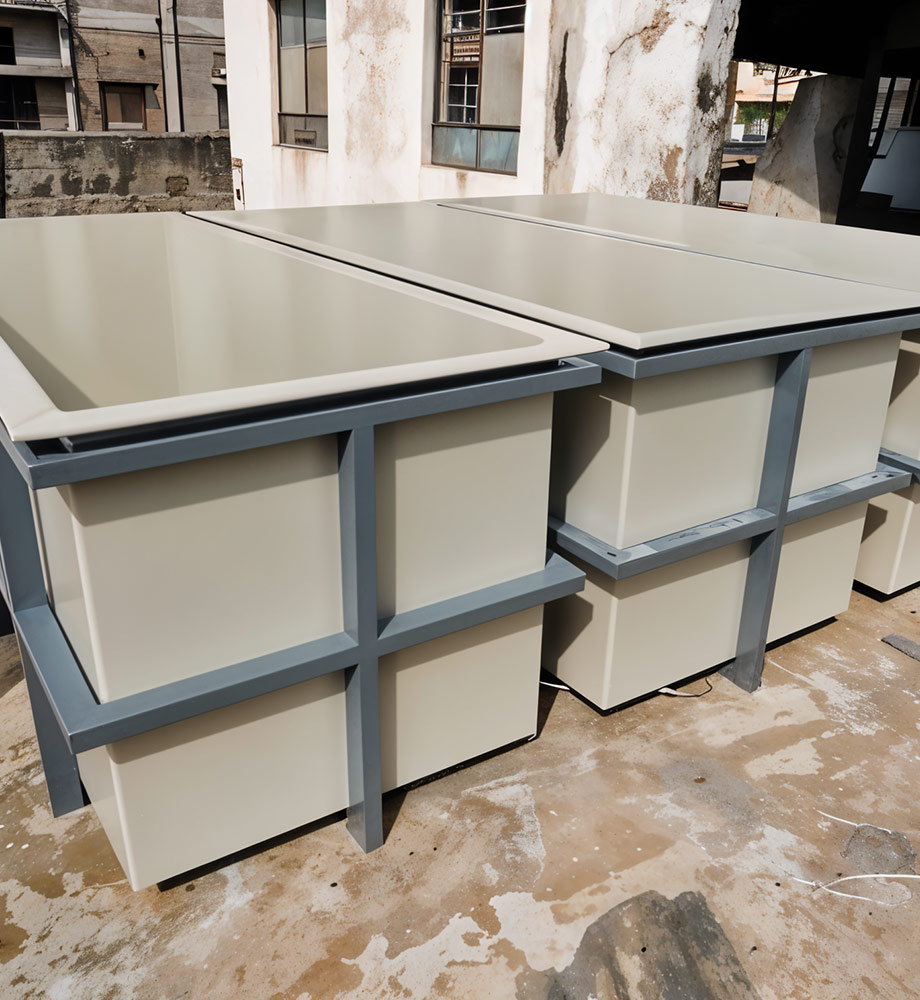Key Features
- Thermoplastic Inner Liner: Continuous, corrosion-proof liner made from polymers like HDPE, Homopolymer/ C-PVC, PVDF or PP, resistant to acids, alkalis, solvents, and sewage gases.
- FRP Structural Shell: Outer composite shell (vinylester or isophthalic polyester) provides strength, stiffness, and pressure-resistance to the tank.
- Thick Corrosion Barrier: Liners can be up to 2 inches thick for severe service, offering wear and impact resistance.
- Machine-Welded Joints: Seamless butt-welded liner assemblies ensure no leaks; industrial welding methods deliver chemical-tight seals.
- Dual-Laminate Design: FRP overliner supports the tank structurally while the liner serves as the primary corrosion barrier, essentially combining the benefits of two materials.
- High Temperature Capability: Many thermoplastic liners can handle elevated temperatures (e.g. PP up to ~100°C, PVDF up to ~150°C).
Benefits
- Unmatched Chemical Resistance: Superior protection against extreme pH, oxidizers, or concentrated chemicals present in industrial wastewater.
- Long Service Life: The durable plastic liner prevents permeation and corrosion of the tank wall, greatly extending life in aggressive environments.
- Leak-Proof Safety: Fully bonded liners eliminate pinholes and leaks, protecting both the tank structure and the environment.
- Versatile Compatibility: Can store acids (e.g. HCl, H2SO₄), alkalies (e.g. NaOH), solvents, salts, slurries, as well as raw sewage.
- Low Maintenance: No need to re-coat or replace lining; routine inspections suffice. Liners are resistant to abrasion from solids.
- Regulatory Compliance: Suitable for storing stringent process fluids; lining materials often meet FDA/NSF 61 for potable uses if needed.
Applications
- Industrial Effluent Tanks: For sectors like chemical manufacturing, metal finishing, pulp and paper, and mining where wastewater contains harsh chemicals.
- Acid & Alkali Waste Storage: Collecting acid pickling or caustic waste streams before treatment.
- Raw Sewage with High Corrosion Potential: In plants handling tannery, food processing, or petrochemical sewage.
- Intermediary Tanks in STP: As buffer/equalization tanks when influent quality varies or contains toxic spikes.
- Pickling, Plating & Electrochemical Plants: Where spent process chemicals are stored safely.
Technical Specifications
- Liner Materials: Options include HDPE, PP (homopolymer or copolymer), PVC/CPVC, PVDF, FEP, ETFE, PTFE, etc. Material chosen for chemical compatibility.
- Wall Construction: Typical tank wall is ~4–10 mm FRP laminate over a thermoplastic liner of ~2–5 mm (or thicker as required).
- Temperature Range: Dependent on resin/liner: up to ~65°C for PVC, 80–100°C for PP/HDPE, 150°C for PVDF/PTFE.
- Pressure Rating: Usually atmospheric; can be engineered for slight positive pressure.
- Certifications: Tanks fabricated under quality systems (e.g., ISO 9001) with traceability; some liners meet NSF or FDA.
- Accessories: Laminated FRP reinforcement rings, flanges, mixers/agitators mounts, heating coils, etc., as needed.
Unique Selling Points (USPs)
- Dual-Laminate Expertise: Industry-leading designs that combine thick plastic liners with robust FRP, providing redundancy and reliability.
- Chemical Processing Heritage: Proven in hundreds of chemical and effluent plants, with experience in the toughest waste streams.
- Custom Fabrication: In-house welding and winding capabilities allow fully customized shapes (vertical/horizontal, cone-bottom, rectangular) to fit any process.
- Quick Lining Process: On-site butt-welding of liners by certified technicians ensures fast, bubble-free installation and minimizes downtime.
- One-Stop Supply: We provide the lined tank, plus any needed support structures or piping, delivering a complete solution to the customer.

